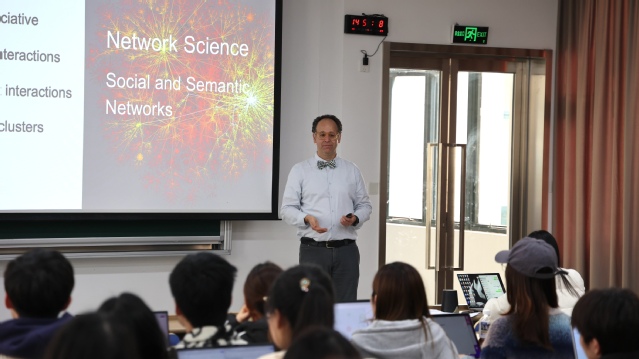
By Lin Liuhan
A highly insightful workshop on social network analysis of social media was held on Shanghai International Studies University’s Songjiang campus, on the afternoon of March 21. The event, which attracted a strong turnout of students and faculty, was led by Itai Himelboim, Associate Professor in the Department of Advertising and Public Relations at the University of Georgia’s Grady College of Journalism and Mass Communication. Professor Chen Peiqin, Vice Dean of the School of Journalism and Communication, hosted the session.
Professor Himelboim provided a thorough introduction to the theory and methodology behind social network analysis (SNA), emphasizing its relevance to communication studies. He explained that social networks are composed of “nodes” (individual users or entities) and “links” (the connections between them), which can represent a range of relationships, including familial, collaborative, or social ties.
Delving into the structure of social networks, Himelboim highlighted the importance of understanding both directed and undirected links. Directed links indicate the direction of relationships, while undirected links reflect mutual or reciprocal connections. He stressed that analyzing these links is crucial to interpreting network dynamics and understanding the strength of relationships.
Using balance theory, Professor Himelboim explored the relationships within triads (groups of three nodes), showing how different patterns of connection can affect the overall stability of a network. This theoretical framework helps researchers understand how clusters of nodes interact and influence each other, with implications for everything from online communities to political networks.
Centrality emerged as a key concept in the discussion, with Professor Himelboim explaining that it measures a node’s importance within the network. He outlined several centrality metrics, including degree centrality, closeness centrality, and betweenness centrality, all of which help identify influential nodes that play critical roles in the network. To make these concepts more tangible, he demonstrated them using a social network graph of the 2023 cohort of master’s students. Each student was represented as a node, with links drawn between them based on their familiarity with each other.
The workshop also touched on density and modularity, two key metrics for understanding network structure. Density refers to the number of actual connections between nodes relative to the maximum possible number, while modularity measures the extent to which the network can be divided into distinct clusters or communities.
In concluding the session, Professor Chen thanked Professor Himelboim for his engaging presentation and encouraged students to explore the growing field of social network analysis further. The workshop ended with enthusiastic applause, as participants left with a deeper understanding of how social media networks can be analyzed and interpreted.
This workshop provided an invaluable opportunity for students to grasp the fundamentals of social network analysis and its practical applications in communication research.

 |Hongkou Campus|550 Dalian Road (W), Shanghai 200083, China |Songjiang Campus|1550 Wenxiang Road, Shanghai 201620, China
|Hongkou Campus|550 Dalian Road (W), Shanghai 200083, China |Songjiang Campus|1550 Wenxiang Road, Shanghai 201620, China